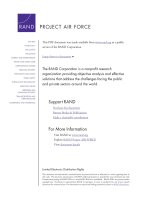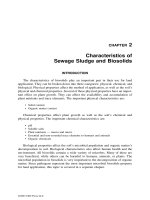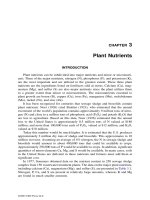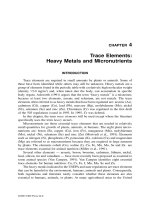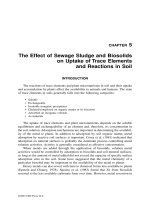Design, control, and application of piezoelectric actuator external sensing and self sensing actuator
Bạn đang xem bản rút gọn của tài liệu. Xem và tải ngay bản đầy đủ của tài liệu tại đây (10.18 MB, 177 trang )
DESIGN, CONTROL, AND
APPLICATION OF
PIEZOELECTRIC ACTUATOR
External-Sensing and Self-Sensing Actuator
ANDI SUDJANA PUTRA
NATIONAL UNIVERSITY OF SINGAPORE
2008
DESIGN, CONTROL, AND
APPLICATION OF
PIEZOELECTRIC ACTUATOR
External-Sensing and Self-Sensing Actuator
ANDI SUDJANA PUTRA
(B.Eng., Brawijaya University,
M.T.D., National University of Singapore)
A THESIS SUBMITTED
FOR THE DEGREE OF DOCTOR OF PHILOSOPHY
DEPARTMENT OF ELECTRICAL AND COMPUTER ENGINEERING
NATIONAL UNIVERSITY OF SINGAPORE
2008
Acknowledgements
I would like to express my sincere appreciation to all who have helped me during my
candidature; without whom my study here would have been very much different.
First and foremost, I thank my supervisors: Associate Professor Tan Kok Kiong
and Associate Professor Sanjib Kumar Panda, who have provided invaluable guidance
and suggestion, as well as inspiring discussions. With their enthusiasm and efforts in
explaining things clearly, they have made research a fun and fruitful activity. I would
have been lost without their direction.
I would also like to thank the National University of Singapore for providing me
with scholarship and research support; without which it would have been impossible
to finish my study here.
It is difficult to overstate my gratitude to the officers and students in Mechatronics
and Automation Laboratory, who have also become my friends. Dr. Huang Sunan,
Dr. Tang Kok Zuea, Dr. Zhao Shao, Dr. Teo Chek Sing, and Mr. Tan Chee Siong
have always been very supportive and encouraging through the easy and difficult time
during my research.
I am indebted to many more colleagues in Faculty of Engineering and Faculty of
Medicine, whose names, regrettably, I cannot mention all here.
Finally, my deepest gratitude goes to my family and close friends. I dedicate this
thesis to you.
i
Contents
Acknowledgements i
Summary viii
List of Tables ix
List of Figures xiii
1 Introduction 1
1.1 Motivation 1
1.2 ResearchObjectives 5
1.3 ScopeoftheThesis 6
1.4 Outline 8
2 Literature Review and Background 10
2.1 Piezoelectricity 10
2.2 Nonlinearity in Piezoelectric Actuator . . . . . . . . . . . . . . . . . . 15
2.3 Design of Piezoelectric Actuator with Mechatronic Approach . . . . . 20
2.4 Control Issues in Relation to Piezoelectricity . . . . . . . . . . . . . . 24
2.5 Mechanical Link for High-Precision Actuators . . . . . . . . . . . . . 27
2.6 AdaptiveControl 33
3 Design, Modeling, and Control of External-Sensing Piezoelectric Ac-
tuator 36
ii
3.1 Introduction 37
3.2 Target Application: Intra-Cytoplasmic Sperm Injection (ICSI) . . . . 42
3.2.1 GeneralProcedure 43
3.2.2 Difficulties with Conventional/Manual ICSI . . . . . . . . . . 46
3.2.3 Current Design of Piezo-Assisted ICSI . . . . . . . . . . . . . 48
3.3 Piezoelectric Actuator for ICSI . . . . . . . . . . . . . . . . . . . . . 50
3.3.1 Linear-Reciprocating Piezoelectric Actuator . . . . . . . . . . 51
3.3.2 Partially-Rotating Piezoelectric Actuator . . . . . . . . . . . . 52
3.4 SystemModels 56
3.4.1 Linear-Reciprocating Piezoelectric Actuator . . . . . . . . . . 57
3.4.2 Partially-Rotating Piezoelectric Actuator . . . . . . . . . . . . 60
3.4.3 Dynamics of the Injection Needle . . . . . . . . . . . . . . . . 65
3.5 ControllerDesign 66
3.6 Results 71
3.6.1 Linear-Reciprocating Piezoelectric Actuator . . . . . . . . . . 71
3.6.2 Partially-Rotating Piezoelectric Actuator . . . . . . . . . . . . 75
3.6.3 Comparison between Linear-Reciprocating and Partially-Rotating
Piezoelectric Actuator . . . . . . . . . . . . . . . . . . . . . . 78
3.6.4 ICSI Experiments and Cell Development . . . . . . . . . . . . 81
3.7 Future Application with Iterative Learning Control . . . . . . . . . . 83
3.7.1 Modeling of the Actuator . . . . . . . . . . . . . . . . . . . . 84
3.7.2 Compensation with a Regulated Chatter . . . . . . . . . . . . 88
3.7.3 Approximate Error Convergence Analysis . . . . . . . . . . . . 92
3.7.4 SimulationStudy 95
3.7.5 Experimental Results . . . . . . . . . . . . . . . . . . . . . . . 96
3.8 Conclusion 98
4 Design, Modeling, and Control of Self-Sensing Piezoelectric Actua-
tor 107
iii
4.1 Introduction 108
4.2 Target Application Microdispensing System . . . . . . . . . . . . . . 111
4.2.1 Working Principle of Microdispensing System . . . . . . . . . 112
4.2.2 Microdispensing System with X-Y Table . . . . . . . . . . . . 114
4.2.3 Design Consideration . . . . . . . . . . . . . . . . . . . . . . . 114
4.3 Self-Sensing Actuation . . . . . . . . . . . . . . . . . . . . . . . . . . 116
4.3.1 SSAMeasurement 117
4.3.2 ErrorAnalysis 120
4.4 Adaptive Control Scheme . . . . . . . . . . . . . . . . . . . . . . . . 123
4.4.1 SystemModel 123
4.4.2 Design of Controller . . . . . . . . . . . . . . . . . . . . . . . 124
4.5 Experiment, Results, and Discussions . . . . . . . . . . . . . . . . . . 125
4.5.1 Experiment 126
4.5.2 Comparison between SSA and ESA . . . . . . . . . . . . . . . 127
4.5.3 Comparison between PID with Adaptive Control and PID-Only
Control 129
4.5.4 Results with Microdispensing System . . . . . . . . . . . . . . 129
4.6 FutureApplication 129
4.6.1 WorkingPrinciple 132
4.6.2 Device Description . . . . . . . . . . . . . . . . . . . . . . . . 135
4.6.3 Design of the Device . . . . . . . . . . . . . . . . . . . . . . . 137
4.7 Conclusion 139
5 Conclusions 141
5.1 Contribution 141
5.2 Recommendation for Future Work . . . . . . . . . . . . . . . . . . . . 143
Bibliography 145
Author’s Publications 160
iv
Summary
This thesis discusses the design, modeling, and control of piezoelectric actuator. Two
major contributions are reported in the thesis: design of external-sensing actuator
and design of self-sensing actuator.
The major contribution of this thesis is that it offers a mechatronic approach in
designing piezoelectric actuators. With the emergence of nanotechnology and along
with the trend of product miniaturization, piezoelectric actuators are gaining increas-
ing attention in the industry as well as in research community; and this emphasizes
the importance of discussing this type of actuators in the field of research. Piezoelec-
tric actuator exhibits nonlinear characteristics and, therefore, control of piezoelectric
actuators constitute an integral part of it and is therefore an important subject,
especially in the face of the high nonlinearity of piezoelectric actuators.
The first major portions of this thesis are the design, modeling, and control
of external-sensing actuator, with application in intra-cytoplasmic sperm injection
(ICSI). The technique of external-sensing actuation (ESA) is the usual, ubiquitous
technique used in closed-loop control systems, where a separate, independent sensor
is used to provide information about the sensing variables to allow the implemen-
tation of feedback control. The main discussion issues are the design steps of the
proposed actuator and the control algorithm used to control the proposed actuator.
The application area considered here, ICSI, is a biomedical application to perform an
artificial fertilization. In this application, the sperm is to be injected into an oocyte
(egg cell) so as to result in fertilization. A partially-rotating piezoelectric actuator
is proposed in this application to provide an injection of the sperm into an oocyte
v
with minimum damage inflicted to the oocyte. A linear-reciprocating piezoelectric
actuator is also presented as an alternative approach to accomplish the same task.
As far as the application is concerned, the aim is to achieve blastocyst level of cell
development with high survival rate.
The second major contribution of this thesis are the design, modeling, and control
of self-sensing actuator, with application in a microdispensing system. The technique
of self-sensing actuation (SSA) is the implementation of a single component to func-
tion as both an actuator and a sensor. This technique is not novel; in fact it has
been around since 1990s and has been employed in several structures for vibration
suppression. This thesis proposes a discussion in the comparison between ESA and
SSA technique, especially in which condition one technique is better than the other,
with detailed study for a system whose reference signal is a switching trajectory. Mi-
crodispensing system, the application area considered here, is a type of manufacturing
process that dispenses liquid in a minute volume and in a precise manner, typically
of the order of microliter. In this thesis, a contacting and a non-contacting method of
liquid dispensing are discussed; one is based on adhesive force principle and the other
one is based on mass inertia principle. The aim is to produce patterns of droplets
with uniform dimension. In addition to focusing on the comparison between ESA and
SSA, the control system and design of the microdispensing system are also discussed.
In the two systems discussed in both cases, adaptive controllers are employed
to overcome the adverse effect of nonlinearity inherited by the piezoelectric actua-
tor. The control system proposed in this thesis follows a scenario of combining a
simple, linear controller to perform major task of trajectory tracking with a more
complicated, non-linear controller to overcome the nonlinearity of the piezoelectric
actuator. Adaptive controller is chosen because of its ability to overcome nonlinear-
ity without high computational requirements and also because it does not require
repetitive reference signal, among other things. Adaptive controller is mainly used
here to overcome the hysteresis of the actuator, although it will also overcome other
vi
types of nonlinearity to a certain degree. As an additional note, the linear controller
used in this thesis is a proportional-integral-differential (PID) controller.
In applying the principle of mechatronic approach, especially in designing, the
application area of the actuator has been considered since the initial stage of the
design, along with the general structure of the actuator and the overall control system.
The aim is to arrive at a synergistic system in executing the prescribed tasks. The
synergy between different parts of the system is an important feature in the design of
the proposed devices presented in this thesis because of the high-precision requirement
of the applications of the said devices.
The modeling of the actuator is aimed at helping to design a satisfactory controller;
especially the adaptive controller. The focus is, therefore, not so much on achieving
an accurate model, but in achieving a viable model that is sufficiently accurate, with
low computational requirements. This thesis does not aim to propose a novel model
of piezoelectric actuator or its nonlinearity. Rather, this thesis presents the use of the
existing models with necessary modifications to suit the applications at hand.
Experiments have been conducted with satisfactory test results obtained. The
proposed devices have been developed and then implemented in the applications. In
the ESA contribution, the piezoelectric actuators for ICSI application have been able
to increase the survival rates from 58 % to 76 %. Furthermore, the self-designed
partially-rotating actuator has reduced the vibration of the oocyte from 1.1943 µm
to 0.5154 µm. In the SSA contribution, SSA technique has reduced the RMS error
from 53.47 µm to 24.26 µm.
Although this thesis is submitted for the field of electrical engineering, and more
specifically in control engineering, the discussions throughout this thesis are not lim-
ited to the traditional topics of control system. It also includes mechanical design,
which is an integral part in any mechatronic system as the ones designed in this thesis.
Furthermore, a rather in-depth description of the application areas is also presented,
i.e. intra-cytoplasmic sperm injection (ICSI) and microdispensing technology. The
vii
description is presented in relation to designing the proposed devices; from mechan-
ical, electrical, and control perspective, as well as system integration of these three
components.
A separate chapter is dedicated to compile the various aspects required in de-
signing the proposed actuators. This chapter covers descriptions of piezoelectricity,
nonlinearity, mechatronic system, control, modeling, and mechanical design. In addi-
tion, adaptive control system is also discussed since this is used to overcome nonlin-
earity in the proposed devices. Although this by no means is a complete discussion
of their wide subjects, it shall provide necessary background and foundation for the
subsequent chapters.
viii
List of Tables
3.1 Specifications of the piezoelectric ceramic . . . . . . . . . . . . . . . . 53
3.2 Tracking error of PID-only controller and proposed adaptive controller 73
3.3 Vibrationoftheoocyte 80
3.4 Results of ICSI experiment . . . . . . . . . . . . . . . . . . . . . . . . 82
3.5 Comparison between Adaptive Control and Iterative Learning Control 84
3.6 Linear Motor Parameters . . . . . . . . . . . . . . . . . . . . . . . . . 86
3.7 Specifications of piezoelectric linear motor . . . . . . . . . . . . . . . 97
4.1 Performance of Self-Sensing and External-Sensing Actuation . . . . . 128
ix
List of Figures
1.1 Number of transistors in Intel microprocessors . . . . . . . . . . . . . 3
1.2 Citation number of piezoelectricity . . . . . . . . . . . . . . . . . . . 4
2.1 Principle mode of deformation of piezoelectric element in cylindrical
coordinate: (a) longitudinal, (b) transversal, (c) shear . . . . . . . . . 14
2.2 Principle deformation of piezoelectric element in cylindrical coordinate:
(a) radial, (b) axial, (c) tangential . . . . . . . . . . . . . . . . . . . . 14
2.3 Hysteresis based on Preisach model . . . . . . . . . . . . . . . . . . . 19
2.4 Piezoelectric stack actuator . . . . . . . . . . . . . . . . . . . . . . . 21
2.5 Ultrasonic piezoelectric motor . . . . . . . . . . . . . . . . . . . . . . 21
2.6 Technology in a general mechatronic system . . . . . . . . . . . . . . 23
2.7 General structure of proposed control system . . . . . . . . . . . . . . 27
2.8 Types of flexures, a. notch joints, b. beam-based joints, c. compliant
joints 31
2.9 Four-bar mechanism using flexures in undeformed (solid line) and de-
formed (dashed line) state . . . . . . . . . . . . . . . . . . . . . . . . 32
2.10 Flexible hinge in Chapter 3 . . . . . . . . . . . . . . . . . . . . . . . 33
2.11 Basic structure of the adaptive controller . . . . . . . . . . . . . . . . 35
3.1 Principalstress 39
3.2 Structureofanoocyte 44
3.3 Mediapreparation 45
3.4 ICSIinstallation 50
x
3.5 Construction of partially-rotating actuator . . . . . . . . . . . . . . . 54
3.6 Tangential deflection (dotted line and solid line represent the cylinder
prior to and after the deflection, respectively) . . . . . . . . . . . . . 56
3.7 Axial deflection (dotted line and solid line represent the cylinder prior
to and after the deflection, respectively) . . . . . . . . . . . . . . . . 57
3.8 Radial deflection (dotted line and solid line represent the cylinder prior
to and after the deflection, respectively) . . . . . . . . . . . . . . . . 58
3.9 Total deflection (dotted line and solid line represent the cylinder prior
to and after the deflection, respectively) . . . . . . . . . . . . . . . . 59
3.10 Deflection of a piezoelectric element . . . . . . . . . . . . . . . . . . . 61
3.11 Comparison of the model and the exp erimental result . . . . . . . . . 64
3.12 Loading diagram of the injection needle . . . . . . . . . . . . . . . . . 65
3.13 Sine wave responses with the adaptive control scheme . . . . . . . . . 74
3.14 Sine wave responses with PID control scheme . . . . . . . . . . . . . 74
3.15 Installation of strain gauge on the piezoelectric cylinder . . . . . . . . 76
3.16 Square wave responses with the adaptive control scheme . . . . . . . 77
3.17 Square wave responses with PID control scheme . . . . . . . . . . . . 77
3.18Vibrationoftheoocyte 79
3.19Oocytedeformation 80
3.20 Step-by-step procedure of piezo-assisted ICSI ((A) The sperm (arrow)
was captured by the injection pipette. (B) The injection pipette pene-
trated zona pellucida. (C) The injection pipette penetrated oolemma.
(D) The injection pipette was inside the cytoplasm. (E) The sperm
(arrow) was expelled to the cytoplasm. (F) The injection pipette was
withdrawn slowly from the oocyte.) . . . . . . . . . . . . . . . . . . . 82
3.21 Block diagram of the proposed control scheme . . . . . . . . . . . . . 89
xi
3.22 Illustration of the overall control signal and constituents (a). the con-
trol signal u
c
(t) from the feedback controller (b). the chatter signal
u
k
(t) (c). the overall control signal u(t) . . . . . . . . . . . . . . . . . 100
3.23 Desired trajectory with smooth start . . . . . . . . . . . . . . . . . . 101
3.24 Tracking error of the PID-only control scheme . . . . . . . . . . . . . 101
3.25 Tracking error with the proposed scheme after 25 cycles . . . . . . . . 102
3.26 Iterative convergence performance, (a) Maximum tracking error (b)
RMStrackingerror 102
3.27 Control signal and tracking error after 25 cycles . . . . . . . . . . . . 103
3.28 Setup of the linear piezoelectric motor . . . . . . . . . . . . . . . . . 103
3.29Desiredtrajectory 104
3.30 Tracking error with PID-only control scheme . . . . . . . . . . . . . . 104
3.31 Tracking error with the regulated chatter signal after 40 cycles . . . . 105
3.32 Tracking performance in 40 cycles, (a) Maximum tracking error (b)
RMStrackingerror 105
3.33 Tracking error with the regulated chatter signal during the 40th cycle 106
4.1 Working principle of the microdispensing system . . . . . . . . . . . . 113
4.2 Design of microdispensing system and its control system . . . . . . . 115
4.3 SSA bridge configuration . . . . . . . . . . . . . . . . . . . . . . . . . 117
4.4 Frequency response of the sensing system in the SSA system (sensing
signal with respect to deformation) . . . . . . . . . . . . . . . . . . . 120
4.5 Profile of the error as an exponential function; A: SSA, B: ESA . . . 122
4.6 Step response of the actuator and the model . . . . . . . . . . . . . . 124
4.7 Structure of adaptive feedforward control . . . . . . . . . . . . . . . . 125
4.8 Microdispensing installation in X-Y table; (1) injector, (2) work piece,
(3) piezoelectric actuator, (4) liquid container, (5) X-axis, (6) Y-axis . 126
4.9 Comparison between the performance of ESA and SSA; (a) overview,
(b)highlighted 127
xii
4.10 Performance of the system; (a) with adaptive controller, (b) with PID-
onlycontroller 130
4.11 Patterns of droplets; (a) circle pattern, (b) array pattern . . . . . . . 131
4.12Gravitationalforce 132
4.13Pressureforce 133
4.14 Surface tension force . . . . . . . . . . . . . . . . . . . . . . . . . . . 134
4.15 Schematic of the device . . . . . . . . . . . . . . . . . . . . . . . . . . 136
xiii
Chapter 1
Introduction
1.1 Motivation
Precision is a key to many successful automation processes. A process may be de-
signed with sophisticated working principle and excellent control algorithm, but if the
precision of the process is not up to the requirements, then the process will not be
able to serve the purpose, resulting in unsuccessful operation. Therefore, it is imper-
ative to design actuators with capabilities of performing actions with an achievable
precision within the range of requirements.
Fundamental and applied works, technologies, and manufacturing processes are
now moving towards product miniaturization, with the requirements of motion control
in terms of positional accuracy of the order of sub-micrometer level. In the early
1980s, semiconductors and biomedical industries started to demand for high-precision
actuators to execute a more precise positioning and manufacturing throughout their
processes. The requirements pertaining to the precision of motion vary substantially
according to the applications of the devices. As such, high-precision actuators are now
in high demand, and are expected to perform various types of actions; from rotation
1
to translation, high torque capability, wide speed range, etc. The application areas
of high-precision actuators are as diverse as aerospace, microelectronic, biomedical,
and nanotechnology. In the following, a brief description of the areas of application
of high-precision actuators is discussed.
Micro-electro-mechanical system (MEMS) is the synergistic integration of me-
chanical and electronic components on a common platform through the utilization
of fabrication in micro- or submicrometer scales (often termed as microfabrication)
[1]. A MEMS component consists of sensors, actuators, and control electronics in
a compact structure and small size. Examples of MEMS components are pressure
sensors, flow sensors, inkjet dispenser, and micromotors, which now practically ap-
pear in many industrial devices. The development of MEMS started with a bulk
pressure sensor in the beginning of 1980s to over 1 million micro-mirror arrays in a
few millimeters chip. Advantages often associated to MEMS are reduction in cost for
mass production, reduction in size, reduction in power consumption, and improving
functionalities and capabilities.
In microfabrication processes, a precision of 10 µm or less is typical. Currently,
structures such as transmission gears, friction drives, and motors can also be man-
ufactured utilizing microfabrication, resulting in small and compact devices. Mi-
crofabrication is also required in the fabrication of integrated-circuit (IC). Standard
processes in IC fabrication include, for example, thin film deposition, photolithog-
raphy, and dopant introduction, all of which demands precision at an atomic level.
Over the years, the density of the components contained in a single chip increases
exponentially, which puts even greater demands on precision. Figure 1.1 [2] presents
the rapidly growing number of transistors in Intel microprocessor over the years.
2
Figure 1.1: Number of transistors in Intel microprocessors
In the field of precision control, especially in high-precision actuation, piezoelectric
actuators are nowadays among the most widely-used types of actuators.
Piezoelectric actuators have received increasing attention in recent years along
with the emergence of new technologies, such as nanotechnology and biotechnology,
which require precision control in unprecedented demand. Owing to many inherent
merits of these actuators, such as, high resolution of displacement, high stiffness and
fast frequency response, piezoelectric actuators have been broadly used in many ap-
plications requiring fine position control, such as rotor bearing [3], diamond turning
[4], scanning accuracy [5], vibration suppression [6], grinding table [7],and microlitho-
graphy [8]. The application of piezoelectric actuators is further fueled by the trend of
miniaturization in applied research and in the industry nowadays. The field of piezo-
electric actuators is now an interesting subject of research worth spending millions
3
of dollars annually. Because of the superior characteristics of piezoelectric actua-
tors in terms of precision, the term piezoelectric actuator is closely associated with
high-precision actuator.
Piezoelectric actuators have also influenced research throughout the world, at-
tracting many researchers from many disciplines. The increasing popularity of piezo-
electric actuators in research field is reflected by the increasing number of citation
mentioning piezoelectric actuators, as presented in Figure 1.2; showing a steady in-
crease of about 300 citations every 4 years.
Figure 1.2: Citation number of piezoelectricity
The design and control of piezoelectric actuators, however, call for special ap-
proach that has to take care the unique properties of piezoelectric materials, as well
as the application to which the actuators are to be used, so as to achieve the require-
ments as prescribed by the applications. Therefore, a design approach that is suitable
4
for designing high precision actuators becomes necessary. The properties of piezoelec-
tric materials that significantly affect the application’s design and the control system
are the nonlinearity, characteristics of travel motion, and piezo-/inverse-piezo-electric
effect, which will be discussed in detail in Chapter 2. The usual approach of design-
ing from off-the-shelf actuators, and of assembling with off-the-shelf transmission is
no longer sufficient [9]. Such approach leaves the connection between parts of the
actuation system – the mechanical system and the electrical system – loose. The
expected design approach should therefore maintain the integration of all parts of the
actuation system; addressing the abovementioned problem.
Apart from the abovementioned motivation, the unique property of piezoelectric
element, in which it can be used as a sensor as well as an actuator, opens up a
possibility of combining these two functions in a single element; resulting in a highly-
integrated system. This enhances the actuation system in several ways as follows:
• full exploitation of piezoelectric capabilities,
• integrated structure of actuator and sensor, allowing modular design for intel-
ligent system.
1.2 Research Objectives
This research focuses on the development of piezoelectric actuators in a comprehensive
manner, in that it tries to cover the issues and considerations right from where the
requirements were set.
Both external-sensing and self-sensing actuators are discussed in this thesis. External-
sensing actuator (ESA) refers to using the piezoelectric element purely as an actua-
5
tor, while a separate sensor is installed in the actuator to measure various outputs.
This is the common approach as other actuators such as DC motors or AC motors.
Self-sensing actuator (SSA) is a special technique that employs the capabilities of
piezoelectric material to act as a sensor. This technique is indeed applicable to smart
materials in general; piezoelectric included.
Along with the abovementioned objective, two general types of mechanism are
discussed: direct-drive and indirect-drive mechanisms. The discussion is presented in
relation to the control system that entails the complete drive-system.
In conjuction, there are also certain applications to be completed with piezoelec-
tric actuators. This is related to the projects undertaken in the Mechatronics and
Automation Laboratory. These applications are intra-cytoplasmic sperm injection
(ICSI) and a microdispensing system.
This research, therefore, covers the general types of actuation system and mech-
anism, with suitable design of control system to adapt to different operating and
actuation condition.
This research was conducted primarily at the Mechatronic and Automation Labo-
ratory of the National University of Singapore (NUS). Parts of the project, especially
the field test part, were also conducted in parallel at the Faculty of Medicine.
1.3 Scope of the Thesis
Pertaining to the design of piezoelectric actuators, a comprehensive procedure requires
the following matters to be discussed:
1. Material design
6
This issue is related to the designing and forming of the material. As will be
explained later in Chapter 2, common piezoelectric material is composed of
ceramics with dopant. Material design discusses topics such as the type and
amount of ceramics, dopant, and their polarization.
2. Mechanical design
This issue is pertaining to the assembly and connection of piezoelectric mater-
ial/element.
3. Electrical design
Electrical design discusses the manner to drive the piezoelectric element.
4. Control system design
Control system design is mainly about how to control the piezoelectric actua-
tors to obtain desirable output. This is especially important when the strong
nonlinearities of piezoelectric actuators are considered.
5. Application examples
The piezoelectric actuators are eventually to be implemented in certain appli-
cations and therefore the applications are also important to consider. The ap-
plications dictate the requirements as well as the constraints of the piezoelectric
actuators.
This thesis attempts to discuss the design and control of piezoelectric actuators
from a point of view of mechatronic systems, which is a synergy between mechanical,
electrical, and computing engineering. The discussion of material design is, therefore,
excluded from this thesis.
7
1.4 Outline
The thesis is organized as follows.
Chapter 2 presents the general issues pertaining to piezoelectric actuator, includ-
ing the design and control aspect of the actuator. This chapter first touches on the
issue of piezoelectricity from the material stand point; without too much detail about
the crystal or the material itself. Next, the inherent nonlinearity of piezoelectric ma-
terial is discussed, mainly on how it affects the performance of piezoelectric actuator.
General concept on mechatronic design pertaining to designing a piezoelectric actu-
ator follows, with an aim to present a general approach that is used throughout the
thesis.
Chapter 3 presents the development of piezo electric actuator with external-sensing
actuation (ESA) technique. This technique is essentially the usual configuration of
feedback control system, where the control system is comprised an actuator and a
sensor; both physically separated. In this chapter, the piezoelectric actuator being
developed is to be applied in an intra-cytoplasmic sperm injection (ICSI) installation.
The piezoelectric actuator is used to drive a glass pipette in a precise manner of the
order of sub-micrometer. The sensor is a strain gauge – which is clearly physically
separated from the actuator, emphasizing ESA technique – and is used to provide a
sensing signal pertaining to the position of the actuator.
Chapter 4 presents the development of piezoelectric actuator with self-sensing
actuation (SSA) technique. This technique combines sensing and actuating functions
simultaneously in one component, i.e. the piezoelectric element. This technique
makes use of the twin properties of piezoelectric material of generating electrical
8
charges up on application of force and generation of displacement upon application of
electrical charges. In this chapter, the application is on a microdispensing installation,
where the piezoelectric actuator is used to drive an injector to dispense liquid in
minute volume.
Finally, conclusions and recommendations for future work are presented in Chap-
ter 5.
9
Chapter 2
Literature Review and Background
This chapter provides the theoretical foundation for Chapter 3 and Chapter 4, which
are the main chapters of this thesis. A great deal of literature exists on the design
and control of piezoelectric actuators as outlined in [10], especially those related
to precision control. The theoretical background covered in this chapter includes
piezoelectricity and its nonlinearity, design of piezoelectric actuator with mechatronic
approach, and control issues in the design of piezoelectric actuators – that touch on
control strategy to drive piezoelectric actuator satisfactorily.
The next two sections are related to the specific application of piezoelectric actu-
ator. Section 2.5 discusses non-conventional links used in systems with piezoelectric
actuators. Finally, Section discusses adaptive control, which will be the backbone of
the control system in overcoming the nonlinearity of piezoelectric actuators.
2.1 Piezoelectricity
The discovery of piezoelectricity is attributed to the research conducted by the French
brothers Curie in 1880. They discovered that certain crystals possesses unique prop-
10


